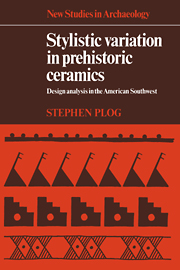2 - The hypotheses
Published online by Cambridge University Press: 27 August 2009
Summary
In this chapter, I will discuss a series of hypotheses which may explain part, but not all, of ceramic design variation within or between sites. A basic premise that guided the formulation of these hypotheses is that design variation is a result of a number of different factors. That is, no one variable will explain a large percentage of the variation in design frequencies but, rather, there are multiple factors each of which will explain a portion of the variation. At a time when archaeologists have increasingly recognized the complex nature of cultural systems, it is surprising and unfortunate that many of those studying ceramic designs have assumed that design variation is not a complex phenomenon and thus could be described and explained very simply.
This oversimplification can be illustrated in several ways. First, there has been a highly selective use of ethnographic information. The primary ethnographic information that was emphasized by studies in the American Southwest, for example, was Bunzel's discovery that Pueblo potters of the 1920s primarily had learned ceramic designs from their mothers (Bunzel 1972:54). This information led to the proposal that design clusters within archaeological sites could be interpreted as the loci of matrilocal residence groups. However, other ethnographic data that would affect the probability that this proposal would be true were ignored (Stanislawski 1973).
- Type
- Chapter
- Information
- Stylistic Variation in Prehistoric CeramicsDesign Analysis in the American Southwest, pp. 13 - 25Publisher: Cambridge University PressPrint publication year: 1980

